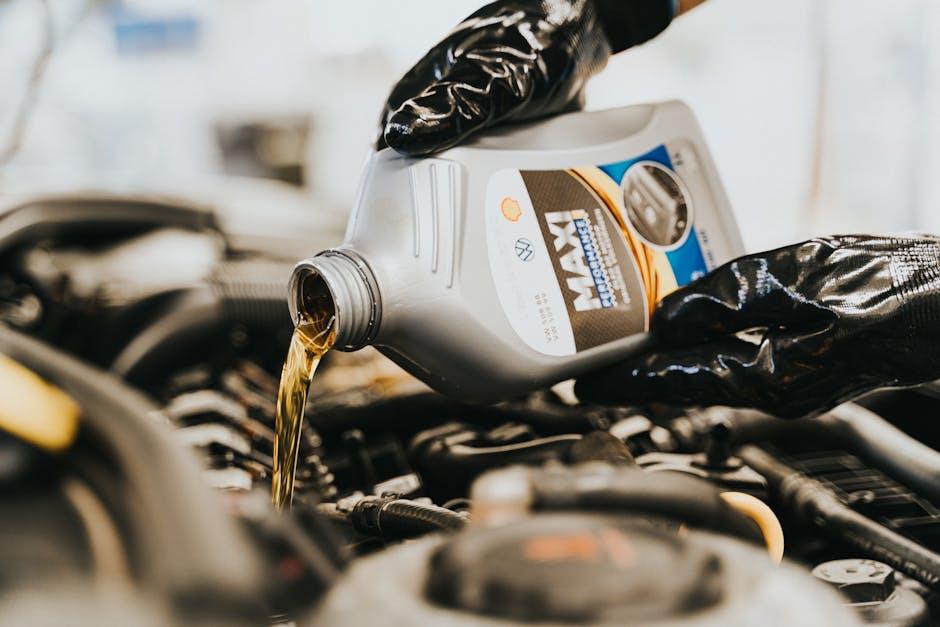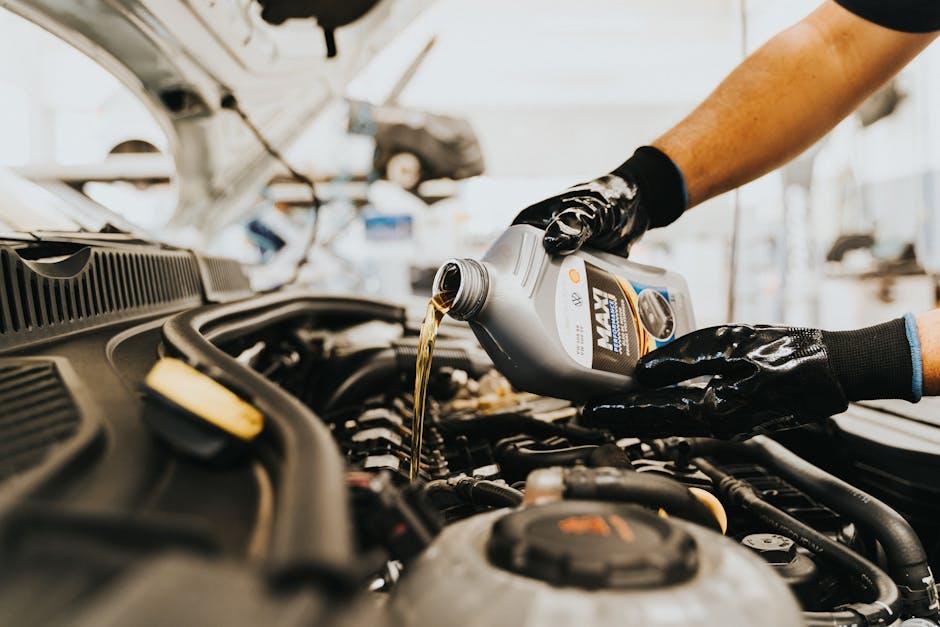When it comes to maintaining your vehicle, few questions are as common—and as practical—as, “How long does an oil change take?” Whether you’re planning a quick pit stop or scheduling routine maintenance, understanding the time involved can help keep your day running smoothly. Delving into the nuances of this essential service, from the simplest DIY to a professional shop visit, reveals that oil changes are more than just routine—they’re a small investment of time with big returns for your car’s health. Let’s explore exactly what goes into an oil change and how much time you should set aside.
Table of Contents
- Understanding the Typical Timeframe for an Oil Change
- Factors That Influence How Long an Oil Change Takes
- Choosing Between Quick Lube Services and Full-Service Mechanics
- Tips to Prepare Your Vehicle for a Faster Oil Change
- How Technology Is Speeding Up Oil Change Processes
- When to Expect Delays and How to Manage Your Schedule
- Q&A
- Future Outlook

Understanding the Typical Timeframe for an Oil Change
An oil change typically takes between 30 to 45 minutes, depending on several factors such as the vehicle type, the location of the service, and whether any additional maintenance tasks are performed simultaneously. For most common sedans and compact cars, a quick oil change can be done in under half an hour by a skilled technician. However, for larger vehicles or those requiring special synthetic oils, the process might edge closer to an hour. Waiting times can vary as well if the service center is busy or if an appointment is required.
Some key elements that influence the duration include:
- Vehicle model – Accessing the oil filter and drain plug can be trickier on some vehicles.
- Type of oil used – Synthetic oils often take more time to drain completely.
- Additional inspections – Technicians sometimes perform quick checks on fluids and tire pressure, adding to the total time.
| Service | Average Duration |
|---|---|
| Conventional Oil Change | 30 minutes |
| Synthetic Oil Change | 45 minutes |
| Full Service (Oil + Checks) | 60 minutes |

Factors That Influence How Long an Oil Change Takes
The duration of an oil change can vary widely based on several critical elements that influence the overall process. First and foremost is the type of vehicle—luxury cars, trucks, and older models might require additional steps or specialized equipment, making the job take longer. Additionally, the kind of oil being used plays a role; synthetic oils usually demand more care but can extend the interval between changes, while conventional oils are quicker to handle but need more frequent replacements. The experience and efficiency of the mechanic or technician also directly impact time, as seasoned professionals can identify and address any complications swiftly.
Other often overlooked factors include the condition of the vehicle’s oil filter, which, if clogged or difficult to access, can add minutes to the task. Environmental aspects like the shop’s workload, available tools, or whether it’s a DIY attempt versus a professional service also matter. Here’s a quick overview of time influencers:
- Make and model of the car
- Type of oil used (synthetic vs conventional)
- Oil filter accessibility
- Mechanic’s expertise and efficiency
- Workshop environment and equipment
| Factor | Effect on Duration |
|---|---|
| Vehicle Type | Simple cars: 15-20 min; Complex vehicles: 30+ min |
| Oil Type | Synthetic takes longer but lasts longer |
| Filter Condition | Clean & accessible: quicker; clogged: delays process |
| Mechanic Experience | Experienced pros speed up the job |
| Workshop Setup | Fully equipped shops complete faster |

Choosing Between Quick Lube Services and Full-Service Mechanics
When deciding where to get your oil changed, it’s important to weigh the advantages of both quick lube services and full-service mechanics. Quick lube centers specialize in speed and convenience, typically completing an oil change in under 30 minutes. They offer straightforward services like oil and filter replacement, topping off fluids, and basic inspections—all designed to get you back on the road swiftly. These centers often shine for their transparent, no-frills approach, making them ideal for drivers with tightly packed schedules.
On the other hand, full-service mechanics provide a more comprehensive vehicle care experience. While the oil change might take longer—often 45 minutes to an hour—they include a detailed multi-point inspection and can address any mechanical issues detected during the service. This attention to detail can save you time and money in the long run by catching potential problems early. Here’s a quick comparison to help you decide:
| Service Type | Average Time | Service Depth | Ideal For |
|---|---|---|---|
| Quick Lube | 15-30 mins | Basic Oil & Filter | Busy Schedules |
| Full-Service Mechanic | 45-60 mins | Oil Change + Inspections | Comprehensive Care |

Tips to Prepare Your Vehicle for a Faster Oil Change
Getting your vehicle ready for an oil change can significantly reduce the amount of time you spend in the service lane. Start by gathering all necessary documents such as your vehicle’s service history and warranty information. This can speed up the consultation process. Additionally, check your car’s oil level before heading in—if the level is critically low, informing the technician beforehand can help prioritize your service. Have your keys and identification at hand, and if possible, clean out the car’s engine bay to give mechanics easy access to the oil filter and drain plug.
Another way to expedite the process is to schedule your oil change during off-peak hours or book an appointment online. When you arrive, park close to the service entrance and make your vehicle easily accessible by removing any bulky items from the engine area and inside the cabin. Here’s a quick checklist to ensure you’re prepared:
- Keep service records handy for quick reference
- Verify oil type recommended for your vehicle model
- Clear space around the engine to speed up filter access
- Book your appointment ahead of time to avoid wait times
- Notify the service staff of any recent engine issues

How Technology Is Speeding Up Oil Change Processes
Modern advancements have dramatically streamlined the traditional oil change process, reducing wait times and improving convenience. Automated systems now assist technicians by rapidly identifying the correct oil type and filter for each vehicle, minimizing human error. Additionally, digital checklists powered by tablets ensure every step is followed meticulously without unnecessary delays. These innovations enable service centers to process more vehicles efficiently, often completing oil changes in under 20 minutes without compromising quality.
Technologies like quick-lift hydraulic platforms and eco-friendly oil disposal setups also contribute to the accelerated pace, enabling simultaneous tasks that were once sequential. Here’s a quick overview of some time-saving tools currently changing the game:
- Smart diagnostic scanners: Instantly check engine health and oil condition.
- Pre-packed oil kits: Ready-to-use packages tailored for specific make/model.
- Automated fluid extractors: Speed up oil removal without mess.
- Mobile app scheduling: Reduces wait by allowing customers to book precise time slots.
| Technology | Time Saved | Primary Benefit |
|---|---|---|
| Smart Diagnostic Scanners | 5 minutes | Accurate oil type selection |
| Pre-packed Oil Kits | 4 minutes | Reduced preparation time |
| Automated Fluid Extractors | 3 minutes | Efficient oil removal |
| Mobile Scheduling Apps | Varies | Reduced waiting times |

When to Expect Delays and How to Manage Your Schedule
Oil changes are generally quick, but certain circumstances can stretch the time needed. Busy service centers, especially during weekends or promotional periods, may cause unexpected waits. Additionally, vehicles with complex engine designs or those requiring synthetic oil blends often take longer. Weather conditions and staffing shortages can also impact timing, turning what should be a simple task into a bit of an ordeal. To avoid surprises, it’s wise to call ahead and ask about current wait times or book your appointment during off-peak hours.
Managing your schedule around these potential delays can save frustration and keep your day running smoothly. Consider these tips to stay on track:
- Plan for extra time: Add a 30-60 minute buffer beyond the advertised oil change duration.
- Use waiting periods wisely: Bring work, a book, or plan errands nearby.
- Schedule strategically: Early mornings or midweek slots often see fewer customers.
| Time of Day | Expected Wait | Recommended Action |
|---|---|---|
| Morning (8-10 AM) | Low | Best for quick service |
| Midday (12-2 PM) | Moderate | Bring work or entertainment |
| Late Afternoon (4-6 PM) | High | Book appointment or call ahead |
Q&A
Q: How long does an oil change typically take?
A: On average, a standard oil change can take anywhere from 20 to 45 minutes. This timeframe includes draining the old oil, replacing the oil filter, adding fresh oil, and performing a quick vehicle inspection.
Q: Does the type of vehicle affect the duration of an oil change?
A: Yes, the complexity of the vehicle can influence the time required. For example, luxury or high-performance cars with hard-to-reach oil filters or specialized equipment might take longer than a typical sedan.
Q: Can a quick oil change service be trusted?
A: Quick oil changes, often done at express service centers, can be reliable if performed by trained technicians using quality oil and filters. However, rushing can sometimes lead to missed issues or improper procedures, so choosing a reputable provider is key.
Q: How does doing an oil change yourself compare in time?
A: If you’re experienced and have all the tools ready, a DIY oil change may take about 30 minutes to an hour. For beginners, it could take longer due to the learning curve and preparation.
Q: Are there factors that can extend the oil change time?
A: Absolutely. Waiting for your turn at a busy shop, needing additional vehicle maintenance, or discovering leaks or worn parts during inspection can add to the total time.
Q: What’s the best way to minimize oil change duration?
A: Scheduling an appointment ahead of time, choosing a trusted mechanic, and knowing your vehicle’s oil type can streamline the process and help you get back on the road sooner.
Q: Is the quality of the oil related to how long the service takes?
A: While premium or synthetic oils might sometimes require special handling, the type of oil usually doesn’t significantly affect the duration of the oil change itself. The focus remains on thoroughness and accuracy over speed.
Future Outlook
In the grand scheme of car maintenance, an oil change may seem like a small pit stop, but it’s a crucial one that keeps your engine humming smoothly. While the exact time can vary—from a brisk 15 minutes to a more thorough hour—knowing what factors influence the process helps set realistic expectations. Whether you’re a DIY enthusiast or prefer the pros to handle it, understanding the timing empowers you to plan your day without unnecessary stress. So next time you schedule that oil change, remember: a few minutes invested today can save you hours of trouble on the road tomorrow.

